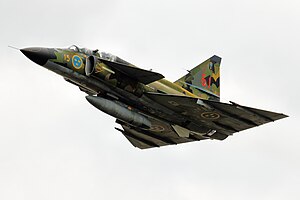
Back Saab 37 Viggen Afrikaans Saab 37 Viggen AN Saab 37 Viggen Azerbaijani SAAB 37 Viggen Bulgarian Saab Viggen Catalan Saab 37 Viggen Czech Saab 37 Viggen Danish Saab Viggen German Saab 37 Viggen Spanish Saab 37 Viggen Estonian
| Saab 37 Viggen | |
|---|---|

| |
| A SK 37 Viggen in flight | |
| Role | Multirole combat aircraft[1]
|
| National origin | Sweden |
| Manufacturer | Saab AB |
| First flight | 8 February 1967 |
| Introduction | 21 June 1971 (AJ 37) |
| Retired | 26 June 2007 (SK 37E) |
| Primary user | Swedish Air Force |
| Produced | 1970–1990[2] |
| Number built | 329[2] |
The Saab 37 Viggen (The Tufted Duck, ambiguous with The Thunderbolt)[3] is a single-seat, single-engine multirole combat aircraft designed and produced by the Swedish aircraft manufacturer Saab.[1] It was the first canard-equipped aircraft to be produced in quantity[4] and the first to carry an airborne digital central computer with integrated circuits for its avionics, arguably making it the most modern/advanced combat aircraft in Europe at the time of introduction. The digital central computer was the first of its kind in the world, automating and taking over tasks previously requiring a navigator/copilot, facilitating handling in tactical situations where, among other things, high speeds and short decision times determined whether attacks would be successful or not, a system not surpassed until the introduction of the Panavia Tornado into operational service in 1981.[5]
Development work begun during the early 1950s to develop a successor to the Saab 32 Lansen in the attack role, as well as to the Saab 35 Draken as a fighter. Saab's design team opted for a relatively radical delta wing configuration, as well as to produce the aircraft as an integrated weapon system that operated in conjunction with Sweden's STRIL-6 national electronic air defense system. It was also designed to be operated from runways as short as 500 meters. Work was aided by the "37-annex" under which Sweden could access advanced U.S. aeronautical technology to accelerate both design and production.[6] The aircraft's aerodynamic design was finalised in 1963. The prototype performed its maiden flight on 8 February 1967 and the following year the Swedish government ordered an initial batch of 175 Viggens. The first of these entered service with the Swedish Air Force on 21 June 1971.
Even as the initial AJ 37 model entered service, Saab was working on further variants of the Viggen. Accordingly, several distinct variants of the Viggen would be produced to perform the roles of fighter bomber/strike fighter (AJ 37), aerial reconnaissance (SF 37), maritime patrol/anti-surface (SH 37) and a two-seat trainer (Sk 37). During the late 1970s, the all-weather interceptor/strike fighter JA 37 variant was introduced. Attempts to export the Viggen to other nations were made, but ultimately proved unsuccessful. In November 2005, the last Viggens were withdrawn from service by the Swedish Air Force, its only operator; by this point, it had been replaced by the newer and more advanced Saab JAS 39 Gripen.
- ^ a b "Viggen - ryggraden i det svenska flygvapnet under tre decennier". Saab (in Swedish). Saab AB. Retrieved 8 March 2023.
- ^ a b Gunston and Gilchrist 1993, p. 247.
- ^ Nilsson, Axel (13 January 2012). "JAS 39 Gripen − Milestones". Projects. Swedish Defence Materiel Administration. Archived from the original on 22 February 2014. Retrieved 12 February 2014.
Swedish naming of aircraft
- ^ Fredriksen 2001, p. 279.
- ^ Zorro, Mario H. (8 May 2016), "Saab S37 Viggen", Plane Encyclopedia.
- ^ Cite error: The named reference
SDRAwas invoked but never defined (see the help page).
© MMXXIII Rich X Search. We shall prevail. All rights reserved. Rich X Search